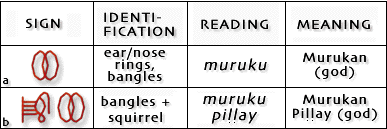The Indus Squirrel Sign: Title of Murukan
The 'Squirrel' Sign: Title of Murukan
 Fig. 3: Bangles and Squirrel Sign
Fig. 3: Bangles and Squirrel Sign
Parpola has proposed reading a pair of signs as 'bangles + squirrel' (Fig.III b), interpreting it as a divine title. The second sign appears to depict a small animal perched on a tree branch. Parpola has, in my opinion, convincingly shown that this animal is the striped palm squirrel shown in its characteristic posture of hanging upside down. Two faience figurines of the palm squirrel have been found at Mohenjodaro. The Tamil word for squirrel is anil (*canil). This loveable creature is often endearingly referred to as anil pillai (pillai being the general term for 'young one'). Parpola suggests that pillai by itself can mean 'squirrel' and the usage may go back to Proto-Dravidian as indicated by the words warce, verce (Gondi) and pirca (Parji) which mean 'squirrel' and are, according to him, cognates of pillay, Thus he reads the pair of signs as muruku pillay taken as referring to the god Murukan with the title pillay. Pillai is attested in Tamil as an appellation of Murukan, as the son of Siva.
Parpola departs in this case from his own rules of rebus, which require the finding of another meaning for the same word ( * canil), and not for an associated term ( * pillay). Further as far as I know, there seems to be no attested usage in Dravidian for pillay by itself to mean 'squirrel'. The suffix pillai is added in Tamil to a wide variety of words to indicate the 'young of the species" and not specifically or even mainly to the squirrel. As regards the Gondi and Parji words for 'squirrel' cited by Parpola, the suggested derivation from * pillay is not supported by regular phonetic correspondences.
